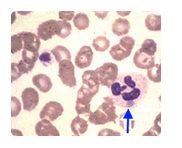Black stopper tubes are used for glucose collections.
A. True
B. False
All of the following activities are associated with platelets EXCEPT:
A. Aggregation
B. Adhesion
C. Lysis
D. Release of granules
Fatty casts contain refractile oval fat bodies or free fat droplets. They are derived from renal
tubular cells, and may be seen in nephrotic syndrome.
Identify the urine sediment element:
A. WBC cast
B. Fatty cast
C. Waxy cast
D. Granular cast
The anticoagulant present in a light-blue stopper tube is:
A. Ethylenediaminetetraacetic acid (EDTA)
B. sodium citrate
C. heparin
D. potassium oxalate
Patient's with diseases such as congential hemolytic anemias and aplastic anemias require
frequent transfusions. Each unit of red cells contains 225 mg of iron, which puts these
patients at risk for iron overload.
Blood Bank
Patients with diseases that require chronic transfusions are at risk for iron overload.
A. True
B. False
May-Hegglin anomaly is a rare autosomal dominant condition in which patients are at risk for bleeding and infections. It is characterized by the presence of large Dohle body like inclusions within neutrophils, eosinophils, basophils, and monocytes. The WBC anomaly indicated by the arrow in this illustration is:

A. Alder-Reilly anomaly
B. Pelger-Huet anomaly
C. May-Hegglin anomaly
D. Toxic granulation
A hospital chief operating officer is responsible for
A. Setting policy and guiding the organization
B. Overseeing the hospital information system
C. Finances
D. Implementing policies and oversight of daily activities
Gram-positive bacteria retain the primary crystal violet stain that is applied in the Gram stain because of the cross-linking of the thick peptidoglycan layer in their cell walls. Their cell walls contain less lipids than that of a gram-negative bacteria, and this reduces the permeability of their cell wall to the organic solvents that are used as a decolorizer. When the counterstain is added, it may enter the gram-positive cell, but does not change the color of the cells. A thick peptidoglycan is MOST often associated with which of the following types of bacteria?
A. Gram-negative bacteria
B. Gram-positive bacteria
C. Both gram-negative and gram-positive bacteria
The best course of action when entering an isolation room is:
A. following the directions from the sign on the door
B. wearing a gown, a mask, and gloves
C. wearing only a gown
D. wearing only a mask
AHG must be added to the cells immediately following washing. Antibodies may elute from the cells if the cells are allowed to sit in saline without the addition of AHG. Which one of the following may cause a FALSE-NEGATIVE result with antiglobulin techniques?
A. Red cell/AHG test sample is over-centrifuged
B. Patient's blood specimen was collected in silicone gel tubes
C. Saline used for washing the test sample has been stored in squirt bottles
D. Addition of AHG is delayed for 40 minutes or more after final saline wash
E. Patient's red cells have an antibody coating them
Serum ferritin is a good indicator of iron deficiency. However, it acts like an acute phase reactant, being elevated in a large number of conditions. Patients who have iron deficiency as well as another condition that elevates serum ferritin levels may therefore have normal or even elevated serum ferritin levels. Which one of the following statements about serum ferritin are true:
A. It is a sensitive indicator of iron deficiency
B. Elevation of serum ferritin is specific for hemochromatosis
C. It is synonymous with transferrin
D. It is a better test for bone marrow iron stores than a Prussian blue stain of marrow particles
Which EBV markers would be MOST likely positive for an individual who had infectious mononucleosis 9 years ago?
A. All would still be positive
B. Anti-VCA (IgM) and heterophile
C. Anti-VCA (IgG) and anti-EBNA
D. None of the markers would be positive after 9 years
| Page 16 out of 47 Pages |
| Previous |